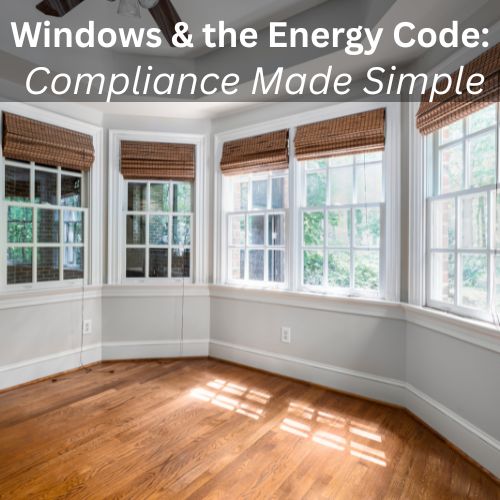
How windows fit into the energy code isn’t just a box to check—it’s a key part of passing your inspection and avoiding costly callbacks. Energy performance starts with fenestration, and understanding how U-Factor, SHGC, and NFRC ratings apply under the International Energy Conservation Code (IECC) can make the difference between a smooth approval and a failed inspection.
This guide walks you through the 2021 IECC window requirements, what the U-Factor and SHGC really mean, and how to ensure you’re in compliance before the inspector even steps on site.
What Is Fenestration?
The term fenestration includes:
- Windows
- Glazed doors
- Skylights
These openings in the building envelope are evaluated for energy efficiency using ratings standardized by the National Fenestration Rating Council (NFRC).
Key Terms You’ll See on Every Window Label
U-Factor (U-Value):
Measures how well a window prevents heat from escaping. Lower U-Factor = better insulation. Required in all zones.
SHGC (Solar Heat Gain Coefficient):
Measures how much solar radiation enters through the glass. Lower SHGC = less heat gain. Required in warmer climates, not typically required in colder zones like 5–8.
NFRC Label:
The National Fenestration Rating Council is the only recognized certification body for window performance. Their labels must remain on the window until inspection. Inspectors use this label to verify code compliance.
What Climate Zone Am I In?
The IECC divides the U.S. into 8 climate zones. These zones are based on historical weather data (temperature, heating and cooling degree days) and are shown in:
- IECC 2021 Table R301.1
- IECC 2021 Figure R301.1 (U.S. Climate Map)
- Or online U.S. Climate Map
In many northern states, including parts of the Midwest and Northeast, contractors are subject to Zone 5, which is heating-dominated. That affects which performance metrics apply.
Prescriptive vs. Performance Path
Prescriptive Path (IECC R402.1.2):
You follow the code directly—every component (window, wall, ceiling) meets the set minimums.
Performance Path (IECC R405 or R406):
You use approved software (like REScheck) to show the home meets energy targets, even if some components don’t hit the prescriptive minimums.
How Windows Fit into the Energy Code by Climate Zone (2021 IECC)
The following table summarizes the prescriptive requirements for vertical fenestration (standard windows, not skylights).
| Climate Zone | Max U-Factor | Max SHGC | SHGC Required? |
|---|---|---|---|
| 1 | 1.20 | 0.25 | Yes |
| 2 | 0.40 | 0.25 | Yes |
| 3 | 0.35 | 0.40 | Yes |
| 4 | 0.32 | NR | No |
| 5–8 | 0.30 | NR | No |
NR = Not Required (prescriptively)
Source: IECC 2021 Table R402.1.2
Other Important Code Requirements
- Air Leakage: Windows must have an air infiltration rate of ≤ 0.3 cfm/ft² per IECC R402.4.3.
- NFRC Labeling: Labels must remain in place until the final inspection. This is required under IECC R303.1.3.
- Installation: Windows must be installed per the manufacturer’s instructions and integrated into the building envelope. This is addressed in IECC R402.5.
Using REScheck for Compliance
If your window U-Factor is slightly above 0.30, or you want more flexibility, you can use REScheck to document compliance via the performance path.
- Tool link: https://www.energycodes.gov/rescheck
- Supports IECC 2021 and earlier code years
- Free to use and accepted in most jurisdictions
REScheck lets you trade off better insulation in walls or attic to compensate for slightly higher window U-Factors.
If you’re unsure how windows fit into the energy code in your zone, reviewing the IECC climate table or using REScheck can save you from installation errors and failed inspections.
What the Inspector Is Looking For

During inspection, make sure the following are clearly visible:
- NFRC label showing U-Factor and SHGC (if required)
- Air infiltration rating (must be on the label or separately certified)
- REScheck report (if using the performance path)
- Proper installation (flashing, sealing, air barrier continuity)
Do not remove the sticker before inspection—even if the window is installed properly, you could still fail if the inspector can’t verify performance.
Summary
Windows are one of the most visible and critical parts of your energy code compliance. The U-Factor, SHGC, and air infiltration rating are not just numbers—they’re enforceable code minimums.
Take the time to:
- Verify your climate zone
- Confirm NFRC label ratings
- Use REScheck if you need flexibility
- Leave labels in place for the inspector
- Install per manufacturer specs
Energy code starts at the window—literally.
You can also read our post on how GFCI requirements impact final inspection for another common compliance issue.